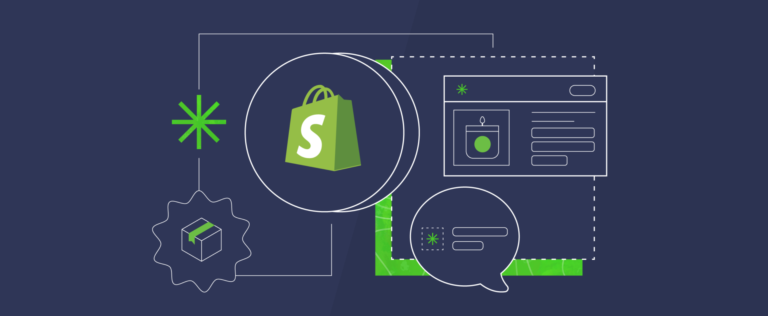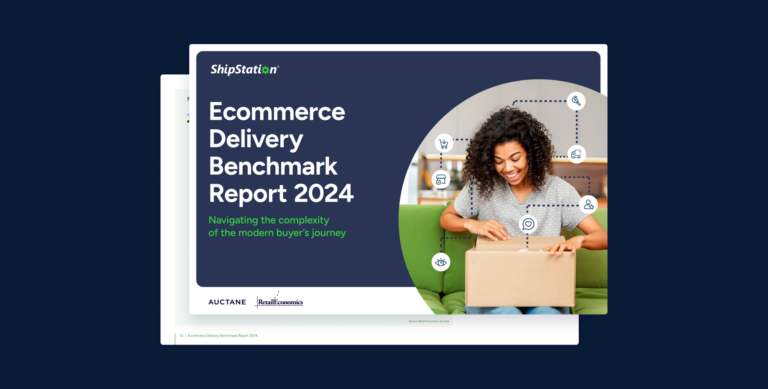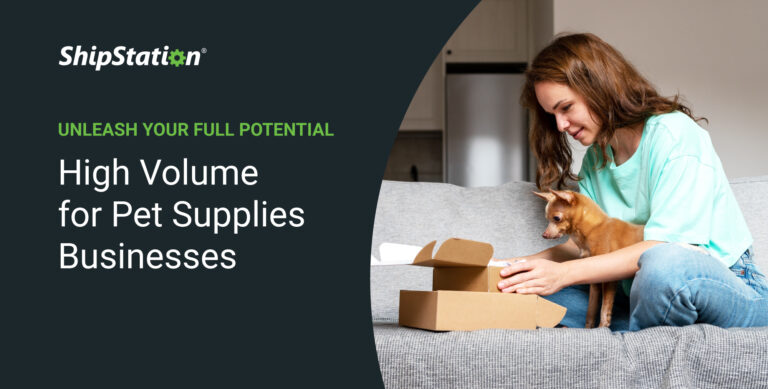Shopify: How ShipStation Can Help Simplify and Automate Your Fulfilment

One of the easiest ways to launch your online ecommerce business, Shopify offers a wide range of features and a toolbox full of features to help you become a success. Fully customisable with endless apps and plugins, Shopify is the perfect platform to grow and scale your ecommerce business.
Choosing a fulfilment solution like ShipStation as part of your Shopify business plan provides an additional level of customisation and support.
Why Shopify Sellers Should Choose ShipStation
Individually processing each order will only work for so long before it becomes overwhelming and time consuming. As your business grows and orders increase, getting deliveries out in a speedy and efficient manner becomes increasingly difficult. This is where ShipStation can help.
ShipStation makes fulfilment even simpler and more affordable for Shopify merchants. With import automation features, ShipStation can apply your preferred delivery method to orders. Print all your labels in batches up to 500 strong and everything is automatically communicated back to Shopify (or the original selling channel) with delivery notifications directly to the customer.
Cut hours from your day, manage a warehouse’s picking and packing workflow, deal efficiently with returns and grow your fulfilment internationally. With ShipStation you have the tools required to scale, letting you focus more time on growing your operations.
How ShipStation Communicates with Shopify Customers
A key advantage of using a platform like ShipStation is eliminating repetitive manual tasks. ShipStation not only helps streamline your order fulfilment and delivery process it also communicates with your customers about the progress of their delivery. Here’s how the process works:
- Order placed in Shopify or in a physical store using the Shopify POS
- Order is imported into ShipStation’s platform
- Order is fulfilled via ShipStation
- ShipStation sends delivery and tracking information back to Shopify
- ShipStation sends customer delivery email (if this option isn’t enabled, Shopify will automatically send notification)
Make Shipping Affordable
Fulfilment doesn’t have to break the bank. With ShipStation, Shopify merchants can access discounted label rates, thanks to our close relationship with carriers worldwide. Using ShipStation doesn’t limit your carrier choice and you’re not required to use our carrier solutions.
ShipStation saves merchants money in many ways by saving time on fulfilment and you don’t have to worry about overtime or hiring additional staff. After all, time is money. However, as much as time is money, money is also money. Finding the cheapest way to deliver a package doesn’t necessarily mean the longest delivery times.
Based on factors like weight, distance, size and speed the cheapest delivery option can vary. Knowing which service to use can be more cost efficient.
Hermes
For packages up to 15kg you can pay between £2.70 – £9.78. Signature services are an additional charge.
Royal Mail
For packages under 100g Second Class Standard is the cheapest at 96p. Whereas Special Delivery services for the same parcel would cost approximately £6.45.
DPD
Pricing is dependent upon weight and size, but next day delivery (NDD) with DPD starts at only £2.
DHL
Like DPD, DHL offers next working day delivery; prices begin at £7.95 and are based on the size of the DHL box used.
You can connect to any existing carrier account for Royal Mail, UPS, Parcelforce, DHL Express and many more. For additional information on connecting to your existing carrier account, read our connect a carrier help article.
Delivering Shopify Orders
Shopify provides its merchants with a wide range of in-cart delivery options, including free delivery and its dynamic Shopify Shipping Profiles. There is no one size fits all approach to shipping and you’ll need to decide what options work best for your business.
Free Delivery
One of the hottest trends in ecommerce, consumers expect free delivery (and free returns!) to be an industry standard. This isn’t relegated to just larger online stores, but smaller merchants as well.
Offering free delivery doesn’t have to erode your margins. To help facilitate your free delivery journey, check out the cheapest ways to delivership a package in the UK and build your pricing strategy to include deliveryshipping costs in product cost. Incorporating shipping into product pricing is a common practice, though it is a very thin line. Too high and you might lose customers to lower priced competitors.
An additional way to protect margins whilst also offering customers free shipping is through a minimum purchase threshold. Quite common with food delivery services, setting a minimum threshold for free delivery often means customers will spend more to meet the minimum instead of paying for delivery.
Delivery Insurance
You may ask yourself why you’d incorporate shipping insurance into your business model. Whilst there is a cost involved with delivery insurance, the cost of lost parcels can impact profit margins far more than the initial cost – and can provide a better customer experience overall.
As a small retailer, you may want to provide customers with the option of purchasing delivery insurance instead of offering it as a standard. You can set this up as a checkout option, and once selected the process can either be a manual addition when printing labels with ShipStation or it can be fully automated.
Importing Orders and Automation
Delivering Shopify orders doesn’t need to be time consuming and ShipStation can help you reclaim precious hours that could be spent elsewhere. ShipStation can automatically apply delivery configurations when your orders are imported into the system. This process can save a great deal of time and avoids common errors associated with manual entry.
Get started with ShipStation automation
Each time you want to ship an order with ShipStation you won’t need to manually select your carrier and delivery service. Simply configure your delivery parameters to automatically apply to your orders as soon as they are imported into ShipStation.
Ways to automate your fulfilment process:
- Single item and single quantity orders – set up product defaults for common orders of the same size and typical carrier. These settings will apply to both international and domestic services.
- Larger orders – use service mapping or have the customer choose their preferred delivery options at the point of checkout. If you set up a shipping profile in Shopify, you can map the corresponding service within ShipStation.
- Set up automation rules – define the criteria you require, these are implemented after product defaults, product presets and delivery presets within the automation process.
Getting parcels out the door
Efficiency is key and between ShipStation’s import automation and streamlined picking and packing workflows, your business will be flying.
ShipStation is much more than printing labels. It also offers cutting edge delivery management that gives you an efficient way to pick the items for your orders, verify the items are correct and pack them into boxes without fear of missed or double-shipped items.
- Packing slip – ShipStation’s scan-based workflows utilise a packing slip. These are commonly included with an outgoing parcel to show which items are in the customer’s order.
- Pick lists – item-centric documents which let you see which items were ordered in the current batch of orders you’re processing.
- Order summary – these fall between the packing slip and pick lists. They are a pick list that is broken up by order number
Personalising the process
Assigning orders to specific warehouses is a way ShipStation provides peace of mind that you’ll avoid duplicate orders being picked. It also provides clear pick lists for employees.
Additionally, you can use ShipStation’s user permissions and restrictions to ensure the right employees have access to everything they need and only what they need.
Batching
If you’re automating your workflow instead of processing individual orders, batching is the logical conclusion. With ShipStation’s batching you can select up to 500 orders and click ‘generate labels’ to have them all print at once. It works well with features like pick lists and order summaries. Along with automation rules, ShipStation users often report this as one of their favourite features.
If you’re always on the go, you don’t have to worry about being in front of your computer. ShipStation Connect and the mobile app not only lets you print the labels automatically, but you can print to any printer that is connected to a computer running ShipStation.
Go international
International delivery can be burdensome. Whilst it’s more expensive and difficult than shipping domestically, it’s not as challenging as it may first appear.
What’s required to deliver internationally?
- Ensure you’re up to date with the VAT and tax requirements of the countries you’re delivering to.
- You may need to use the internationally recognised harmonisation codes that allow your packages to pass through customs easily.
- Customs forms are required for deliveries. ShipStation will create these and print them out with the delivery label. If they are submitted electronically, ShipStation will also transmit them through the carrier.
- Decide who will pay the taxes and duties
Returns
The order fulfilment process isn’t finished when you box up a shipment. You still need to get it to the carrier and ensure it’s been delivered to the customer. The final step of the delivery process may be stressful, but properly dealing with delivery and returns is the ideal way to elevate your brand image with customers.
The culture of returning goods purchased through ecommerce websites doesn’t seem to be slowing down. Here are a few ways you can improve customer experience through the returns process:
- Offer 14/30/60-day return policies with longer periods during the holiday season
- Decide on what type of returns you want to offer:
- Self-service returns – a favourite among customers who don’t want to wait in queues to return items.
- Free vs paid for returns – customers prefer free returns, though offering this is not always feasible for small businesses. Find ways to make returning products affordable if you can’t provide free returns.
- Flat rate returns – the simplest option for a paid return and no surprises for the customer.
Deliveries don’t have to be a challenge to overcome. ShipStation’s main priority is simplifying and streamlining the order and fulfilment process enabling you to focus on growing your business.
Using an adaptive fulfilment platform will allow you to expand and transform your ecommerce to scale with your growth. Shopify ensures selling is covered, while ShipStation ensures products will get to customers in a quick and efficient way. As you incorporate more elements into your tech stack and expand beyond your current size, ShipStation and Shopify can grow with you.
Download the Shopify Merchant’s Shipping Guide for the UK eBook for a more in-depth look at using ShipStation in conjunction with your Shopify store.


